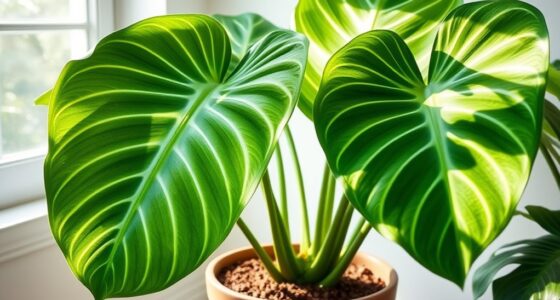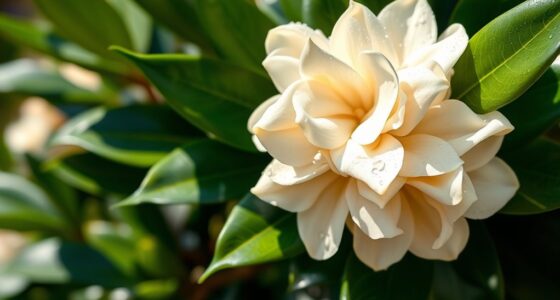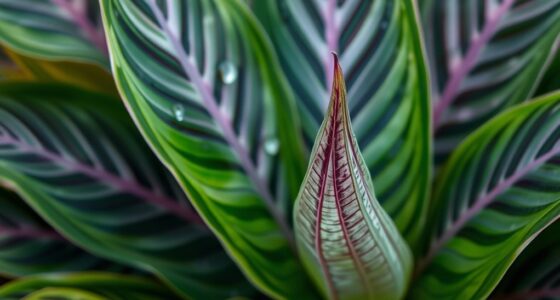To create a thriving indoor jungle, choose hardy houseplants like pothos and snake plants that suit your space and lifestyle. Incorporate realistic synthetic plants to fill empty spots and add vibrant color with stylish pots and lighting. Group plants with similar needs, guarantee proper watering, and give them enough light—natural or artificial. Add furniture like cozy chairs to relax among your greenery. Keep exploring for more tips to transform your space into a lush, welcoming oasis.
Key Takeaways
- Select hardy, forgiving houseplants like snake plants and pothos suited to your space and light conditions.
- Incorporate high-quality synthetic plants to add volume and color without maintenance.
- Use decorative pots and proper lighting, including grow lights if necessary, to support healthy growth.
- Group plants with similar needs and maintain appropriate humidity levels for thriving indoor greenery.
- Create cozy spaces with garden furniture to enhance relaxation and encourage regular plant care.

Transforming your living space into an indoor jungle is a rewarding way to bring nature inside. To achieve this lush look, you don’t need only live plants; incorporating synthetic plants can add volume and color without the extra maintenance. High-quality synthetic plants look remarkably realistic and can fill corners or empty shelves, giving your space a vibrant, full feel. They’re especially useful if you’re just starting your collection or want to add greenery that stays perfect year-round. Pairing these with garden furniture, like stylish outdoor-inspired chairs or tables, creates cozy spots where you can relax among your plants, blurring the line between indoor and outdoor living. This combination allows you to enjoy a verdant environment without worrying about watering or light conditions for every plant.
When selecting houseplants, choose varieties suited to your space and lifestyle. For example, snake plants or pothos are hardy and forgiving, thriving in lower light and requiring minimal watering. Regularly rotating your plants ensures even growth and keeps your indoor jungle lively. Remember to check each plant’s specific needs—some thrive in humidity, while others prefer drier air. Consistent care, like watering when the topsoil feels dry and providing appropriate light, helps your collection flourish. Grouping plants with similar requirements simplifies care and enhances visual appeal. Use decorative pots and plant stands to add aesthetic interest, elevating your indoor garden to a curated display. Additionally, understanding the financial impact of popular entertainment industries can help you make more informed decisions about your investments and hobbies.
Lighting plays a vital role in maintaining a thriving collection. Natural sunlight is ideal, but if your space lacks windows or receives limited light, consider installing grow lights. These can mimic sunlight and promote healthy growth, especially for plants that require bright conditions. Humidity levels can also impact your plants’ health; placing a humidifier nearby or grouping plants together creates a microenvironment that mimics their natural habitat. Regularly inspecting your plants for pests and diseases ensures they stay healthy, and pruning helps maintain their shape and encourages new growth. Don’t forget to dust your synthetic plants occasionally to keep them looking fresh and realistic.
Finally, creating a relaxing corner with garden furniture can turn your indoor jungle into a peaceful retreat. Think about adding a comfortable chair or a small table where you can unwind amid your greenery. This setup not only makes your space more inviting but also encourages you to spend more time caring for your plants, strengthening your connection with your indoor garden. Whether you’re a seasoned plant collector or just starting out, blending natural and synthetic plants with stylish furniture transforms your home into a lush, vibrant sanctuary that’s both beautiful and functional.
Frequently Asked Questions
How Do I Identify Pests on My Houseplants?
To identify pests on your houseplants, start by inspecting your plants regularly for visible signs like discolored leaves, sticky residue, or webbing. Look closely for tiny insects such as aphids or spider mites. Early pest prevention is key, so catch symptoms early for effective treatment. By symptom identification and routine checks, you can prevent pest infestations and keep your indoor jungle healthy and thriving.
What Are the Best Soil Types for Indoor Plants?
Think of soil as the nurturing foundation for your green sanctuary. You want a mix that offers excellent soil drainage so excess water doesn’t drown roots, and rich organic amendments to feed your plants’ growth. Choose a balanced blend of peat, perlite, and compost, ensuring your indoor plants stay healthy and vibrant. This combination creates a lively, well-draining environment, giving your houseplants the perfect home to flourish indoors.
How Often Should I Repot My Houseplants?
You should repot your houseplants every 1-2 years to maintain a healthy watering schedule and root health. Signs like root-bound growth, slowed watering, or yellowing leaves indicate it’s time. Repotting helps refresh the soil, prevent root rot, and promote better nutrient absorption. When repotting, choose a slightly larger container and use fresh soil to keep your plants thriving and guarantee they don’t become overcrowded.
Can I Grow Tropical Plants in Low Light?
Ever wondered if tropical plants can thrive in low light? The answer is yes, but you’ll need to get creative. Shade-tolerant species like pothos or snake plants adapt well, and artificial lighting can help boost growth. Keep in mind, though, not all tropical plants will flourish without ample sunlight. With the right mix of shade-tolerant species and artificial lighting, you can create a lush indoor jungle even in dim corners.
What Are Natural Ways to Fertilize Indoor Plants?
You can naturally fertilize your indoor plants using compost tea or fish emulsion. Compost tea provides essential nutrients and improves soil health, while fish emulsion is a quick, organic boost rich in nitrogen. Mix these solutions according to instructions, and apply them to your plants regularly. This method keeps your houseplants healthy and thriving without synthetic chemicals, promoting a lush, vibrant indoor jungle.
Conclusion
Just like Tarzan thrived in his lush jungle, your houseplants can flourish with a bit of care and attention. Think of your indoor jungle as your personal Eden—each leaf and stem a proof to patience and love. With the right tips, your space transforms into a vibrant oasis where life blooms at every turn. Embrace the journey, and soon you’ll find your home teeming with lush, thriving greenery—your very own paradise.









